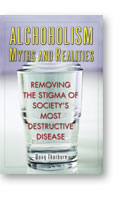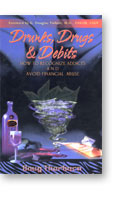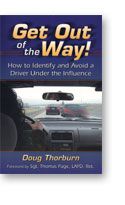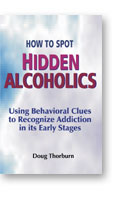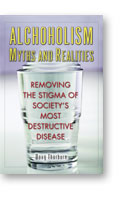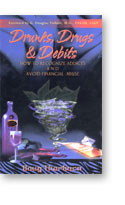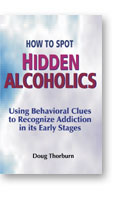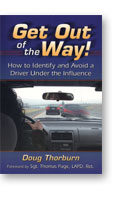 |
|
Issue #67 - October/November/December 2011
|
|
October - November - December 2011
Viewing the news through the lens of alcohol and other-drug addiction
IMPORTANT NOTE: We may switch email services, which will require that each of you opt in to the new service.
Two months is longer than we like between issues of the Thorburn Addiction Report, but there’s been a dearth of alcoholism-related news for which a unique perspective can be offered. In addition, we released the fall issue # 46 of Wealth Creation Strategies, available here (you may find the discussion of Howard Buffet and why taxing the “wealthy” is counter-productive, as well as the article on how best to audit-proof your tax records, of interest). And we got very busy with the end of the “real” tax filing season (mid-October), after which we took a wonderful vacation to Maui. Via Blue Hawaiian Helicopters we actually got to see one of the rainiest spots on the planet, Pu’u Kukui, the highest peak (5,787 feet) on the western “head” of Maui, with an average and very evenly distributed yearly rainfall of 386 inches (our pilot told us it was only the tenth time in ten years he was able to see the top, which is usually shrouded in clouds). Fortunately, we missed the helicopter ride just a few weeks later in which all five people aboard were killed, yet one more example of how precious—and unpredictable—life (and trade winds) can be.
The Top Story in this issue offers evidence that those who own exotic animals are more frequently alcoholics than in the overall population. The “Review of the Month” discusses six reviews of biographies. While considerably longer than our usual review, I felt the length was warranted in order to demonstrate that biographers can’t possibly make sense of their subjects’ lives when they don’t view their subjects through the lens of alcoholism. The myth-of-the-month shows why variations in the abuse of power can be understood only by taking into account the stages of alcoholism and factors such as circumstances of the addict, not just the addict’s social status. Please read on and enjoy!
|
|

|
Welcome to the Thorburn Addiction Report in which we interpret the news through the lens of alcohol and other drug addiction. Each month, we bring you several sections, including: 1. Top Story of the month along with runners up, persons under watch, enablers, disenablers and more 2. Review or Public Policy Recommendation of the month 3. Dear Doug in which a recent letter to "Dear Annie" or other "help" column is rewritten, with responses given from the unique perspective that alcohol or other drug addiction best explains the misbehaviors described 4. Alcoholic Myth-of-the-Month 5. Alcoholic Antic-of-the-Month, usually where someone deserves the Darwin Award, but lived. There is something for everyone!
Addiction Report Archives here
© 2011 by Doug Thorburn
|
|
The blog is open to your comments. We’ll be interested in any thoughts you, our loyal readers, may have.
Books Here
|
|

Is alcoholism the best explanation for owning exotic animals, their release into civilization and the suicide of owner Terry Thompson?
Terry Thompson, 62, released 56 wild, exotic animals, including lions, Bengal tigers, leopards, monkeys, bears, mountain lions and at least one wolf from his 73-acre Zanesville, Ohio property before committing suicide. Thompson had previous run-ins with neighbors, who had repeatedly complained about animals escaping, and the local sheriff’s office, which had charged him with animal cruelty and neglect. He had been released from federal prison only a month earlier after serving a year for possessing unregistered firearms (133 of them, including a machine gun and several guns with missing serial numbers). He had recently split up with his wife. He owed at least $68,000 in property and income taxes, and was recently hit with a federal tax lien.
This combination of extreme risk-taking behaviors, defiance of convention, conflict with the law, problems with neighbors, family and finances and ultimate suicide provide compelling evidence that Terry Thompson’s life story is best explained by alcoholism. One of many ways to defy convention in excessive, risk-taking ways is by owning exotic animals, as suggested in the Antic-of-the-Month of issue # 51 of TAR (October 2009). Throughout my work I have shown that the commission of crimes is fueled by addiction at least 80% of the time (compelling evidence for which is provided in Drunks, Drugs & Debits: How to Recognize Addicts and Avoid Financial Abuse). In a talk I give to Enrolled Agents entitled “Alcoholism, Your Clients and Tax Fraud,” I include a list of another speaker’s “10 Greatest Tax Scofflaws of All Time,” which include at least seven alcohol and other-drug addicts. The other speaker, Sharon Kreider, EA, CPA knew nothing about my work when she compiled the list. Since alcohol and other-drug addicts comprise only 10% of the population, if addiction was not connected to tax fraud we would expect to find only one addict among the ten. Based on this anecdotal evidence, the odds of addiction in someone who commits tax fraud could be at least 70% (but it’s probably closer to the 80%+ likelihood of those who commit crimes generally). Extrapolating from this and my own experience as an EA for over 30 years, I’ve found the likelihood of addiction in someone severely behind in tax obligations to be at least 50%—and probably much higher for a person with net assets (likely for someone who owns a 73-acre farm with at least 56 wild animals) or who “should” have net assets. Furthermore, Thompson appears to have been going through a divorce, 40% of which involve at least one addict. And he committed suicide, which I argue in How to Spot Hidden Alcoholics: Using Behaioral Clues to Recognize Addiction in its Early Stages (pp. 108-109 and footnotes) results from one’s own addiction-caused problems at least 70% of the time. Any two of these clues gives roughly 80% odds of alcoholism; combined, they seem almost irrefutable.
One long-time friend of Thompson commented “he just wasn’t thinking right.” No doubt, but confabulated thinking is a manifestation of alcoholism. The same friend also suggested he suffered post-traumatic stress disorder. While this might be true, Myth # 64, “’Personality disorders are more common than alcoholism,’ or a variation, ‘He’s no alcoholic—he’s just crazy!’” in Alcoholism Myths and Realities: Removing the Stigma of Society's Most Destructive Disease establishes that those with mental disorders are usually not crazy—they are usually alcoholics. Another long-time friend of Thompson excused his decision to release the animals and commit suicide, saying he was not a nut, but was driven to act the way he did by crazy neighbors and law enforcers and didn’t have any other way out. We’re sorry for your friend, but non-alcoholics usually figure out a way of dealing with life’s obstacles and challenges in reasonable and civilized ways. Alcoholics, due to damage to the neo-cortex—the “human” part of the brain responsible for reason and logic and for restraining the impulses of the lower brain centers—often take unreasonable actions to resolve conflicts, which Thompson clearly did.
The unfortunate aspect to Thompson’s history and the death of 48 wild animals (shot by local authorities, who were under a mandate to protect nearby residents) is there probably were, as is true for nearly every alcoholic on the planet, dozens if not hundreds of opportunities for close people or the law to intervene before tragedy occurred. Given his felony conviction, the law had both an excuse and a reason to coerce and enforce abstinence, but didn’t. If Thompson had alcoholism, and since abstinence often leads to sobriety, the tragedy of Thompson taking his own life and the death of so many extraordinary animals was completely unnecessary.
Thorburn Addiction Report Archives
|
|
Runners-up for top story of the month:
Former Los Angeles Dodgers outfielder Milton Bradley, 33, arrested after a verbal argument escalated with Bradley swinging a baseball bat at his wife, who then ran out of their home. Bradley previously made TAR twice: once in the “under watch” category of issue # 6 (January 2005), when he pleaded guilty for having yelled at police using profane language for a traffic stop that went “awry,” and in the “runners-up” section of issue # 14 (September 2005), where police responded to reports of domestic violence three times in 33 days. His wife, who was four months pregnant at the time, refused to press charges. In 2002 he was taken to a hospital after refusing to leave a restaurant and was, according to the medical report, “severely intoxicated.” Mr. Bradley, it’s pretty obvious your alcoholism takes potentially lethal form. It’s time to seek sobriety, before you kill someone you love (or even an innocent bystander).
Deborah Bradley, whose 11-month old daughter Lisa Irwin “disappeared” after she put the baby to bed, admitting she was drunk the night of the “disappearance” and admits she doesn’t remember anything occurring after 6 p.m. While Lisa may have been abducted, there may be another, darker explanation: she might have hurt her daughter. Bradley told NBC that she rejects the notion she could have harmed her daughter while under the influence. “No, no, no. And if I thought there was a chance, I’d say it. No. No. I don’t think alcohol changes a person enough to do something like that.” True enough for a non-addict, but unfortunately not true for one with alcoholism. Ms. Bradley, please Google “murder committed during an alcoholic blackout” so you may better understand your disease, which by now you should; your mother, Lisa Netz, had been in recovery for eight years before her death and many other members of your family have been in and out of trouble all of your life, with many admitting to their alcohol and other-drug addictions.
Denny Ray Hardin, 52, who ran the Private Bank of Denny Ray Hardin out of his home, convicted on 21 felony counts relating to creating, marketing and selling $100 million in fraudulent and worthless financial documents. Using his home computer to produce more than 2,000 “bonded promissory notes,” he claimed the bonds were backed by a Treasury Department account and could be used to pay off debts. He charged a “fee” for the notes, which was substantially less than the face value of the notes, leading some to jump at the “deal.” Creditors who refused to accept Hardin’s notes were threatened with legal action by Hardin. It would be comical if it weren’t so sad that some people actually believed the joker pictured here; on the other hand, many of those who believed him might have been not just gullible, but also as high as he was (which is a polite way of suggesting perhaps they got what they deserved).
Former “Hannah Montana” and current Disney’s “Pair of Kings” star Mitchel Musso, 20, arrested for DUI after being stopped for failing to slow down at an intersection where police officers were directing traffic. Let’s hope Musso doesn’t end up 46 years later like Hawaii entertainer Cecilio Rodriguez, 66, recently arrested on suspicion of sex crimes that occurred in the 1990s, committed against two teenage girls. By the way, Rodriguez was convicted of DUI a month before his arrest.
Nathan Walter Sikkenga, 31, who told Florida Highway Patrol troopers after the crash into a security gate arm bar that he instructed his 9-year-old son to drive his van home because he and his wife were too drunk to drive. In a similar story, Shawn Weimer, 39, whose 9-year-old daughter, sitting in a booster seat behind the wheel at 3 a.m., quizzically asked police after she was pulled over, “What did you stop me for? I was driving good.” At the preliminary hearing she testified that her father had been drinking Black Velvet whiskey all night but “wasn’t drunk.” Some day, little girl, should you survive your father’s insanity, you will understand that “drunk” is often evident in bizarre behaviors and actions long before there is slurring, staggered gait or bloodshot eyes.
Under watch:
In an early 2009 piece on white collar crime, The Economist magazine mentioned something those who have read my books would predict: “Many [Club Fed and other white collar] prisoners suddenly discover, post-conviction, that they had a drinking problem….” I would add that those who don’t figure this out might benefit from greater introspection. In the spirit of The Economist’s discovery, a recent story follows for which the evidence of alcoholism is in the crime itself.
Jerry Sandusky, accused of sexually assaulting several minor male children, both while he was a football coach for Penn State and after he retired from coaching. The accusations are so compelling and the allegations were covered up so fully, Penn State has fired a number of top people who “should” have known about the alleged abuse and “should” have reported it to authorities. Anyone aware of addiction who found evidence of addictive use by Sandusky would have known the alleged crimes were credible and, if in a position to do so, should have done everything possible to inspire in Sandusky a need to get sober. Addictionologists would ask was Sandusky under the influence when the alleged abuses occurred? If he was, there were no doubt dozens if not hundreds of incidents for which close people or the law could have intervened but didn’t, long before it went this far. If he wasn’t, Sandusky would be among the 20% or less of perpetrators of felonious criminal behavior whose behaviors cannot be explained (but never excused) by addiction. Until further evidence of addictive use surfaces, we’ll give Sandusky the benefit of the doubt: if he committed the acts, he’s probably an alcoholic.
Enablers of the month:
Those protecting Jerry Sandusky’s apparent secrets and alleged criminal behaviors, including Joe Paterno, the longest-tenured football coach ever in Division 1 of the NCAA and Mike McQueary, the former assistant coach at Penn State who claims he saw Sandusky sodomize a 10-year-old boy in a campus locker room.
Monique Bradley, wife of former Los Angeles Dodgers outfielder Milton Bradley. See “Runners-up of the month,” above for details. To her credit, she filed for divorce in early 2011. On the other hand, this sort of misbehavior has been going on since at least 2002 and they have young children. In addition, if it’s unclear why she had to run out of “their” home after he swung a bat at her recently, you’re not alone. (Were they reconciling? Was he invited over? Did he just “show up?”) Such craziness is typical wherever there are addicts.
Likely relapse of the month:
Shareef Allman, 47, who after conquering his “inner demons” and dedicating his life to God after running up a string of minor criminal convictions two decades earlier, went on a shooting rampage at a quarry near Cupertino, CA, killing three people and wounding seven others. Santa Clara County Sheriff Laurie Smith described Allman as a “disgruntled worker.” Note to Sheriff Smith: since he committed a series of violent attacks against his now ex-wife in the late ‘80s and early ‘90s and “inner demons” is a euphemism to describe the convoluted thinking of alcoholics, he would likely be better described as a “recovering addict who relapsed and whose addiction took form in lethal behaviors.”
Likely recovering addict of the month:
Basketball star Ron Artest, who recently legally changed his name to Metta World Peace. In “Might alcoholism have precipitated the NBA brawl?”, the Top Story of issue # 5 of TAR (December 2004), I wrote: “With a history of out-of-control behaviors, Artest was previously forced into anger management therapy….While there are no reports of addictive use of alcohol or other drugs by Artest in anything I have read, he clearly makes our ‘under watch’ list….” When John Green, then 39, started the brawl by throwing a cup of beer onto the court at a sprawled-out Ron Artest, the overreaction suggested addiction in the victim: Artest jumped into the stands and threw punches as he climbed over seats. He was later arrested (twice) for threatening an ex-girlfriend in 2006 and now admits (and, hence, could be now sober) that while playing for the Chicago Bulls from 1999 to 2002, “I used to drink Hennessey [cognac] at halftime.” (Note that those “under watch” due to behaviors alone, for whom there is no proof of addictive use, in time frequently become eligible for Top Story or “runner-up of the month.”) In explaining the pathetic 1999-2002 record his first team suffered (the Chicago Bulls lost 188 games out of 241), in typical alcoholic-excuse fashion Artest said he drank more because the team stunk and the team stunk because he drank more. Bear in mind, recovering alcoholics often misunderstand their own disease and he could have easily said this when sober. Mr. Artest: we welcome what appears to be sanity, as well as an admission of your problem, although the name change—an ego-inflating one—suggests it may not last.
Note to family, friends and fans of the above: the benefit of the doubt is given by assuming alcoholism (they are either idiots and fundamentally rotten, or they are alcoholic/other drug addicts—which would explain the misbehaviors). If alcoholic, there is zero chance that behaviors, in the long run, will improve without sobriety. An essential prerequisite to sobriety is the cessation of enabling, allowing pain and crises to build. Thus far, many have done everything they can to protect the addict from the requisite pain, making these news events possible. The cure for alcoholism, consequential bad behaviors and, ultimately, tragedy, is simple: stop protecting the addict from the logical consequences of misbehaviors and, where possible, proactively intervene.
|
|

|
|

Viewing the subjects of biographies through the lens of alcoholism
I’ve long maintained that fundamental changes to personality resulting from alcoholism are so all-encompassing we cannot understand an alcoholic’s life without an appreciation for “euphoric recall,” whereby the addict views everything he says or does through self-favoring lenses, and its inevitable result, an inordinately large sense of self-importance. This egomania is fueled by wielding power, taking three main forms: abuse of others, a willingness to take extraordinary risks and overachievement. These behaviors of alcoholics are completely different from those that occur if addiction is never triggered. Further, behaviors committed by any particular early stage alcoholic are dramatically different from those committed later in life, as the addict spirals into the latter stages of addiction. Biographers, please take note.
Admittedly, this can confuse the observer, who may be a biographer. After all, most people don’t expect to see overachievement by someone who physically, emotionally or financially abuses others. Moreover, when reckless risks don’t pan out, the results manifest as impaired judgment rather than overachievement. Instead of success, we may witness failure, which tends to deflate that inflated ego and, without abstinence, leads more quickly to obvious late-stage alcoholism. As a result, alcoholism not only takes countless forms, but even many forms in the same person, depending on the addict’s current circumstances, environment and where he is in the progression of his disease.
Understanding an alcoholic is impossible without comprehending distortions of perceptions, the resulting egomania and behavioral changes relating to the stage of addiction. The early stage may be characterized by extraordinary overachievement, seeming success in one’s personal and business life and complete functionality. As the addiction takes hold and success turns to occasional failures, the alcoholic may become far less functional and more often appear (and actually be) “drunk,” he may begin to lose jobs or spouses and eventually lose friends and standing in his community. This trajectory can take decades, which makes it impossible for the uninitiated to make sense of an addict’s life. I have long maintained that without understanding alcoholism and identifying it, biographers, as well as journalists and historians, can’t really comprehend their subjects’ lives, as well as the current events and history for which addicts are so often responsible. Unfortunately, almost none grasp the fundamental ideas—the distorted perceptions, god-like sense of self and need to inflate the ego at the expense of others—of alcoholism.
Six recent reviews of biographies (all from The Wall Street Journal) are typical in their failure to recognize their subjects’ underlying behaviors as rooted in alcoholism and, hence, truly comprehend their lives. Either alcoholism wasn’t mentioned at all, or was but only as of peripheral interest or in helping to explain a continuation (but not instigator) of murky behaviors. Incredibly, alcohol or other-drug addiction wasn’t mentioned at all in the review of a new biography, A Thousand Lives: The Untold Story of Hope, Deception and Survival at Jonestown by Julia Scheeres, which suggests it wasn’t mentioned in the book either. Yet the review (“The Horror, The Horror,” The Wall Street Journal, October 7, 2011) chronicles the life of by far the most sadistic addict among the six reviewed here. Jim Jones convinced 900 men, women and children into committing “Kool-Aid suicide” (really Flavor Aid with cyanide) in Jonestown, Guyana in 1978. While a reviewer may omit a biographer’s identification of alcoholism, the author herself (if she has any clue as to the nature of the disease) shouldn’t make the same omission when being interviewed. Yet, in a recent radio interview, Scheeres failed to mention Jones’ proven addiction to alcohol and amphetamines, which is by magnitudes the best explanation for his megalomania and unparalleled ability to sell such an absurd and deadly idea. Amazing, too, the reviewer wrote, “While we may never understand exactly why so many people agreed to die, we can be sure that drugs, isolation and Jones’ depravity all played a part….[and that] Temple leaders ordered vast quantities of tranquilizers and Thorazine, ‘liquid cosh,’ in order to drug the members.” So we are told that his victims were drugged, but not him, even though anyone responsible for drugging someone else (a felonious, not to mention abominable behavior) is almost assuredly an addict himself. Only by understanding addiction and identifying the perpetrator of the horrific acts can we make sense of such tragedy, which Ms. Scheeres either didn’t uncover (even if obvious from Jones’ history) or at best seemed so unimportant to her it would go unmentioned in both a review of her book and a radio interview.
In a review of John Huston: Courage and Art by Jeffrey Meyers (“The Man Who Would be King,” The Wall Street Journal, October 15-16, 2011), Richard Schickel discusses the author’s description of director John Huston as “always charming and insouciant” yet “a bad and elusive father, a terrible husband to five wives and a largely absentee lover of literally hundreds of mistresses.” Huston’s sadistic streak extended from his professional to his personal life and “he was not very nice, the occasional grandiose gesture aside.” Incredibly, his alcoholism isn’t even mentioned in the review and, by extension, possibly not in the book either. If it is, it’s obviously not discussed as an explanation for his behaviors—every one of which mentioned here is not only consistent with but best explained by alcoholism, with any other explanations not even distant seconds.
In a review of Van Gogh: The Life by Steven Naifeh and Gregory White Smith (“A Stranger to Himself,” The Wall Street Journal, October 15-16, 2011), reviewer Jonathan Lopez says the authors described Vincent Van Gogh as “a strange boy,” which suggested to the reviewer that a purported mental illness may already have been present. However, while Lopez at least mentions the heavy drinking, he gets cause and effect backward, writing: as his “behavior grew erratic…he drank heavily, sought out low company and had a protracted romantic entanglement with a prostitute.” This is very different from writing (as I would), “As his alcoholism took hold, he continued to drink heavily and his behavior grew increasingly erratic. He sought low company, including a prostitute with whom he had a protracted romantic entanglement,” which makes much more sense of Van Gogh’s volatile behaviors. His alcoholism-impaired judgment and alcoholism-fueled need to inflate his ego are the best explanations not only for his contentiousness, dangerous confrontations, reliance on his brother for support, disorderly habits, self-mutilation, institutionalization and ultimate untimely death, whether by suicide or “misadventure,” but also his extraordinary accomplishments. At least a review of the same book in The Economist does better: the second paragraph begins: “The book describes a lonely, bad-tempered alcoholic….”
Carol Tavris in reviewing Sybil Exposed by Debbie Nathan (“Multiple Personality Deception,” The Wall Street Journal, October 29-30, 2011) also gets a bit closer to the mark in stating that Sybil’s (whose real name was Shirley Mason) psychiatrist, Cornelia “Connie” Wilbur, “turned [Sybil] into an addict, giving her nearly a dozen drugs, including barbiturates, tranquilizers and anti-psychotics.” Yet Sybil was already suffering from various physical and emotional ailments long before she began treatment with Connie, suggesting that Sybil was already an addict or suffered severe trauma due to being raised by one. Either reason could explain Sybil’s need to please Connie, including her subsequent cooperation in agreeing to help Connie commission a New York magazine writer, Flora Rheta Schreiber, to write and publish a book on Sybil’s made-up multiple personalities (Sybil: the Classic True Story of a Woman Possessed by Sixteen Personalities, first published in 1973). Tavris writes, “The disorder…results from suggestion, sometimes bordering on intimidation, by clinicians.” While intimidation suggests to the addictionologist that Connie’s behaviors might best be explained by addiction, the idea isn’t broached.
As an aside, Tavris explains that after the Multiple Personality Disorder (MPD) bubble burst in 1995 due to malpractice suits, including one by several patients who sued a St. Paul psychiatrist alleging the use of “punitive methods” to induce their so-called “multiple personalities,” “Psychological researchers went on to scientifically discredit virtually all the assumptions underlying MPD.” I read Sybil way back in the 1970’s and thought it was fallacious. I was unaware that MPD was more recently so thoroughly debunked, perhaps because those responsible for the DSM (the psychologists’ manual of personality disorders) renamed the supposed disorder as “dissociative identity disorder,” and continue to insist it exists. While it may occur in real life on exceedingly rare occasions without benefit of alcoholism, it’s almost always yet another alcoholically-induced fabrication.
Reviewer Allan Massie praised biographer Paul Hendrickson (“The Slow Crack-Up,” The Wall Street Journal, September 24-25, 2011) for knowing as much about Ernest Hemingway as anyone ever, having studied him for 30 or 40 years via “all” the other biographies, countless articles, library archives, his children and many others who knew him. The main question raised in Hemingway’s Boat, “what went wrong with Hemingway?” is answered with full knowledge of Hemingway’s well-known alcoholism, but according to Hendrickson his troubles “went deeper.” This is a classic example of a biographer who fails to comprehend early-stage alcoholism, when the alcoholic may be incredibly productive and completely functional. Hendrickson insists that Hemingway’s artistic decline and ultimate despair cannot be explained by any one thing; “that matter is too complicated. There are no simple explanations,” accepting only that “his dependence on alcohol is obviously another explanation of his decline.” While there are never simple explanations for the particular path that alcoholism takes, there is a simple explanation for the thread of craziness, successes and failures woven through the life of every alcoholic: alcoholic egomania in the early years and, should he live long enough, the brain’s failure to produce neurotransmitters on its own in later years, when the addict is unable to function without the sauce. This accounts for his early success, the company he kept, the sudden change from middle age to old-looking, how he could be kind and generous but also often fully capable of “appalling behavior” (including “shocking brutality, vulgarity and stupidity”), as well as his final artistic decline and despair. This did not likely result from an exhaustion of material as Hendrickson suggests; but rather an almost predictable result of late-stage alcoholism, when many authors develop “writer’s block.”
Reviewer Jeanine Basinger (“Hollywood’s Favorite Actor,” The Wall Street Journal, October 29-30, 2011) doesn’t shy away from repeating author James Curtis’s acknowledgement in Spencer Tracy: A Biography that Tracy was “throughout most of his life…an alcoholic.” Spencer Tracy “disappeared on lengthy binges, sometimes trashing hotel rooms,” and when on a double-date that he and Loretta Young had with Josie and John Wayne was “well blasted before dinner” and was carried to his hotel room by Wayne. During one week in 1945, Tracy “ran amok” in New York and was ultimately admitted to Doctors’ Hospital. Yet, both Basinger and Curtis still miss the progenitor of it all, despite Curtis’s recognition that Tracy’s drinking did not stem from his supposed guilt over his son’s deafness, as is apparently commonly believed by other biographers. Basinger writes, “The truth is no one today can really know what made Tracy so angry, so guilty, so unhappy—and so drunk—for so much of his life. Mr. Curtis sketches Tracy’s human flaws with clarity and tact. He doesn’t try to explain what he can’t explain.” Of course, we know better: alcoholism explains Tracy’s binges and charm, his running amok and achievements, his ill health (and consequential early demise) and his charisma. It explains Spencer Tracy.
Most biographers, journalists, public policy analysts and historians, fail utterly to make sense of alcoholic subjects of their biographies and a human history filled with events created or deeply affected by alcoholics and the manifestations of their disease. Being unaware of euphoric recall and figuring out the connection to egomania, which manifests in the abuse of others, reckless risk-taking, a “God” complex, overachievement and a sense of invincibility, it is impossible to make rhyme or reason out of behaviors that otherwise fly in the face of logic. It will be a very different world when those who chronicle the perpetrators of such behaviors, current events and history “get it.” When that era arrives, biographies, news and histories will be re-written in ways that will make the original versions almost unrecognizable.
Click here to check out Doug's movie reviews.
|
|

Thanksgiving boor
Dear Doug:
For the last few years, my husband has invited a friend of 35 years to our annual Thanksgiving party. From the start, this divorcee bellies up to our bar and, while mixing drinks for the men, entertains them with stories of his conquests, business deals and travels. He monopolizes conversation throughout the meal while ignoring or rudely dismissing any female guests who try to speak. Right after dessert he yawns and, thankfully, leaves.
Although he’s ruined the last two Thanksgiving dinners, my husband feels sorry for him and can’t stand the idea his friend might spend Thanksgiving alone if we don’t invite him. What can I do to change my husband’s thinking?
Signed,
Boored to death
Dear Codependent,
Other columnists might suggest you compromise and suggest a family-only dinner with a dessert package consisting of his friend and all the drinks and regaling he wants. However, this misses the main cause of his behavior: alcoholism (even if it’s taking a somewhat odd form here).
Usually, alcoholics want to continue their conquests, especially sexual ones, which unless he’s gay he obviously isn’t interested in. However, since your husband has been “friends” with him for 35 years, the “friend” may be approaching late-stage alcoholism. He may no longer be able to perform as he once did with the lady-victims, or he blames women for his woes (including at least one divorce) and they have become the target of his wrath. The other behaviors he is displaying are entirely consistent with alcoholism, including sidling up to the bar before anything else and then sitting there, inflating his ego with his (tall) tales. The best thing you and your husband could do is to arrange an intervention, before he has no friends left with whom to intervene (a huge problem for getting late-stage addicts sober). You’ll find him to be a much better dinner guest if and when he gets sober, not to mention a truer friend for your husband. In the meantime, don’t invite him to any dinner, much less Thanksgiving.
(Source for story idea: Ask Amy, September 27, 2011.)
And a bonus Dear Doug:
Soccer mom’s coach’s mom problem
Dear Doug,
For three years, my daughter has been on a soccer team with a wonderful coach. The coach’s mother, however, is a loud, mean witch. She taunts referees, yells insults to coaches and parents on the other side and screams at girls on our team to play the way she wants, even though we otherwise enforce a no-coaching-from-the-sidelines rule. Would an anonymous note to the coach or her mother be appropriate?
Signed,
Soccer Mom
Dear Codependent,
Other columnists would tell you that everyone already knows the coach’s mom is a trouble-maker. It must be adversely affecting the kids and, therefore, something must be done. Such columnists would suggest having a private word with the coach, all the while acknowledging the coach is in a difficult spot.
You bet the coach is in a difficult position. Her mother’s behavior is not only affecting her in her coaching career, but no doubt also in her home and every other facet of her life. She may have lived with it while growing up for twenty years and has suffered, along with everyone else, ever since.
In many similar situations, family members don’t link behaviors to likely alcoholism. They’ve grown up with it and, because they see the same (or even worse) behaviors between drinking episodes (or simply don’t see the drinking) they often fail to connect the dots between the behaviors and the heavy drinking or using. The biography of actress Betty Davis by her daughter, B. D. Hyman, discussed over five wonderful pages of Drunks, Drugs & Debits (pp. 166-170), is instructive: Hyman doesn’t mention her famous mother’s drinking until page 47 of the book (My Mother’s Keeper), doesn’t mention it again until page 114, never even mentions the possibility of alcoholism until the family doctor explains she’s going through alcoholic withdrawal on page 269 (after a series of strokes put her in the hospital, where she didn’t have access to her drug of choice) and concludes that the best explanation for her mother’s serial misbehaviors was her need “to prove who’s strong enough to win.” Your coach could easily be as unaware as was B. D. Hyman.
The coach needs a different private word: intervention. The intervention should focus on getting the coach’s mother out of your lives, utilizing the services of a qualified interventionist who understands how to deal with the coach, who is severely codependent. Until and unless the coach’s mother has several years of sobriety, the problems will continue, both on the playing field and everywhere else the mother goes. The coach can deal with her mother later, with her own family.
(Source for story idea: Ask Amy, October 12, 2011.)
|
|

“Our findings indicate that the experience of having power without status, whether as a member of the military or a college student participating in an experiment, may be a catalyst for producing demeaning behaviors that can destroy relationships and impede goodwill.”
So found a study, reported by Peter Pappas on his blog, by three universities showing that people holding positions of power with low status tend to demean others. This is a half-truth, since the study appears to completely omit alcoholism as an explanation for their findings.
Peter Pappas, a CPA, income tax professional and blogger whose work I have found immensely useful, observes, “I have dealt with all levels of IRS employees in my 20 plus years of tax practice and I find [the] theoretical conclusions to be absolutely true in practice. The rudest IRS employees and the ones most likely to disrespect taxpayers and their representatives are the ones with the least status.”
It’s difficult to disprove or otherwise dispute such findings via the lens of alcohol and other-drug addiction. The reason isn’t that alcoholism can’t explain such findings; it probably does, but in a convoluted way because of the innumerable forms of alcoholic behaviors. These vary based on the stage of alcoholism, circumstances, environment (including upbringing), particular drug of choice, afflicted person’s psychological type and temperament, his or her biochemistry and virulence of the strain of addiction inherited. Since they vary tremendously, explanations are difficult.
However, let me try. I would hypothesize that IRS agents with little status can’t easily inflate their egos by saying to family and friends, “Look at how successful I am!” Taking the path of least resistance, they (especially collectors, as opposed to auditors) inflate their egos at the expense of taxpayers and their reps by demeaning them.
What about the more successful alcoholic IRS agent who becomes a group manager? Why bother with belittling comments when much more powerful tools are available? They can ruin lives, which more than makes up for disparaging others.
Similarly, alcoholic police officers may belittle and even get physical with their victims. Rather than doing something so ordinary, higher-up cops, such as district attorneys, have no need to act like those beneath them, whom they no doubt malign if not verbally, at least in their minds. In myth # 83 in Alcoholism Myths and Realities, “Law enforcers can always be trusted to tell the truth and act appropriately,” I relate the story of Charles Whitman, District Attorney of New York, who framed police lieutenant Charles Becker for murder. Using false witnesses and suborning perjury, Whitman was able to convict Becker, but only at a second trial. The Governor of New York was convinced of Becker’s innocence and intended to commute his sentence, but not before Whitman was elected Governor of New York. The new Governor Whitman was so drunk on the eve of Becker’s execution, two assistants physically supported him the entire time that Becker’s wife pleaded for a stay, which his wife felt he couldn’t even understand much less agree to.
At least fewer IRS employees are alcoholics than policemen and prison guards. But there’s a compelling reason: it’s not as ego-inflating to boast at a bar about being an IRS agent as it is to tell the hot babe sitting on the stool next to you that you’re a cop.
|
|

Story from “This is True” by Randy Cassingham, with his “tagline:”
“NOT A COMPELLING ARGUMENT: ‘You are going to make me lose my job,’ whined Donald Leet, 37, to Hillsborough County, Fla., sheriff's deputies. He had drunk ‘a glass of wine’ with dinner, so naturally he had let his girlfriend's 11-year-old daughter drive. The girl lost control and crashed into the First Baptist Church of Brandon, severing a water pipe, which sent water spurting 50 feet into the air. Deputies arrived to find the girl climbing out the driver's side window, with a 7-year- old girl right behind her. ‘Why don't you arrest a rapist or murderer instead of me?’ Leet demanded. ‘You're an illiterate Southerner. You don't know anything. You only have a high school diploma. You're dumb.’ Deputies noted his comments in their report, and arrested him on two charges of child neglect. Why not drunk driving? ‘He was drinking,’ said sheriff's Deputy Larry McKinnon, ‘but we couldn't charge him with DUI. The little girl was driving.’ (RC/St. Petersburg Times, WFTS-TV) ...Dang it. There's always a loophole.”
So, you thought Nathan Walter Sikkenga and Shawn Weimer (last of the “Runners-up” above) were stupid? Ha!
While I really shouldn’t comment on this one (it really does speak for itself), the idea for a public policy recommendation is compelling. A person under the influence who has a unlicensed minor drive for them should be eligible to be convicted of DUI or some equivalent in terms of penalties, in addition to penalties relating to child endangerment and having any unlicensed person drive for them. Maybe double all of the penalties for having a minor child under age 16 (maybe 14) driving.
And by the way, “a glass of wine” is nonsense. This is the sort of reporting (even though it’s in quotes) that could lead the uninitiated to believe that a glass (or even two or three, the latter of which would increase a 120-pound person’s blood alcohol level to .075 per cent after one hour of drinking) could cause a person to be under the influence under “per se” rules for DUI (which consider a person legally intoxicated if the blood alcohol level is .08 per cent or higher, regardless of whether they can pass a sobriety test). On the other hand, if the person goes by the name of Nicole Richie, it might only take two drinks….
(Story and tagline from “This is True,” copyright 2011 by Randy Cassingham, used with permission. If you haven't already subscribed to his newsletter—the free one at least, or the paid one I get, with more than twice the stories—I highly recommend it: www.ThisIsTrue.com.)
|
Comments
To view reader's comments on last month's Thorburn Addiction Report and Doug's responses please visit the Thorburn Weblog at PrevenTragedy.com.
Thorburn Blog
|
Doug's new book, Alcoholism Myths and Realities, is now available at
GaltPublishing.com, Amazon.com and bookstores near you.
"Every policymaker in America needs to read your book exposing the myths of chemical addiction...Excellent book."
— Jim Ramstad, Member of U.S. Congress (MN)
"My father died of alcoholism. His father died of alcoholism. Three generations of alcoholism is enough. Now is the time to abandon superstition and pseudoscience, to debunk the myths surrounding alcoholism, and to apply science to solving this problem. Doug Thorburn's book is a model example of how this should be done. Read it and be prepared to change your thinking on this important topic. When enough of us understand what is really going on with alcoholism, society can make the shift from treatment to prevention and intervention."
— Michael Shermer, publisher, Skeptic Magazine and columnist, Scientific American
Buy your copy of Alcoholism Myths and Realities for only $14.95 or get the whole collection PLUS a two-hour audio cassette from Galt Publishing for just $49.95 plus tax and shipping. That's a $72.75 value for only $49.95.
To order online, click the following link (be sure to put "TAR SPECIAL" in the comments section of the order form.) Orders can also be placed by phone: 800-482-9424 OR fax: 818-363-3111.
If you wish to pay by check, send the appropriate payment with your shipping information and the words "TAR SPECIAL" in the "memo" section of your check to: PO Box 7777, Northridge, CA 91327.
Click here to purchase any of the above Thorburn books
|

Have you visited the Prevent Tragedy Foundation" The Prevent Tragedy Foundation is a tax-exempt 501c-3 organization, the goal of which is to educate the general public on the need for early detection of alcohol and other drug addiction. The Foundation is intended to answer a question that has been all-but-ignored by similar organizations: what does alcoholism look like before it becomes obvious"
Click here to visit the Prevent Tragedy Foundation |
|
Subscriptions
The Thorburn Addiction Report is a free newsletter published by Galt Publishing and PrevenTragedy.com. Subscibe by visiting our web site at www.PrevenTragedy.com.
|
The Thorburn Addiction Report is available to newspapers as a regular feature column.
Inquiries are invited.
Copyright Doug Thorburn All Rights Reserved.
ALL broadcast, publication, retransmission to e-mail lists, WWW or any other copying or storage, in any medium, online or not, is strictly prohibited without prior written permission from the author. Manual forwarding by e-mail to friends is allowed if 1) the newsletter is forwarded in its entirety and 2) no fee is charged. Please forward no more than three issues to any one person -- after that, they should get their own free subscription. We appreciate people who report violations of our copyright to us.
TO COMMENT to the author,
send your email to report@preventragedy.com or write to
Doug Thorburn, P.O. Box 7777, Northridge, CA 91327-7777
|
 |




